What is prestressing of concrete?
Tensile stresses are undesirable for concrete, so to eliminate the same, the compressive stresses generated from external loads are introduced in concrete as per the design requirements by the use of stretched reinforcement called tendon in prestressed concrete terminology. The introduction of compressive stresses in concrete through tendon improves the apparent tensile strength, and the method is known as prestressing of concrete. So, tensile forces applied during its service condition are wiped out up to its apparent tensile strength in concrete due to prestressing in concrete.
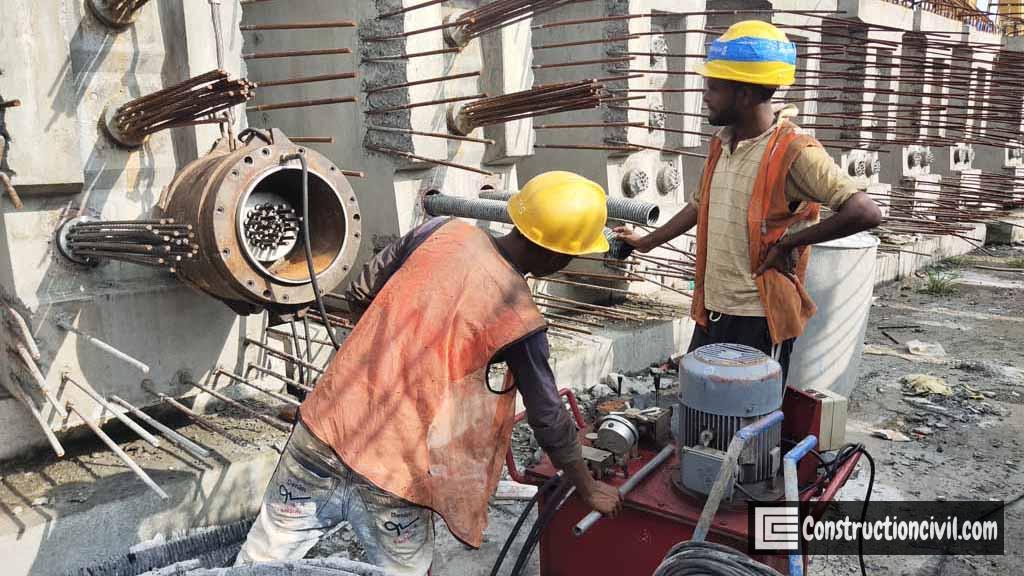
Also, Read: Environment Health and Safety(EHS)
Type of Prestressing:
Considering the type of construction in terms of when the prestressing tendons are stressed and how the prestressing load is transferred into the concrete member, prestressing of concrete may be categorised into two types :
Pre-Tensioned:
prestressing strand tensioned before casting of the concrete member. After concreting around the strands, and when the concrete attains the required strength, the strands are released. Prestressing force is introduced into the concrete by bond.
Post-Tensioned:
It is a method of prestressing in which tendons are placed inside sheathing ducts or passages provided in concrete after concrete gains sufficient strength. Tendons are then stretched and anchored at the ends of the concrete member. In this form of prestressing, the prestressing force is transferred to concrete through anchorages provided at the ends.
Material and for prestressing of concrete:
The list of materials and equipment required for prestressing of concrete are mentioned below:
Prestressing strand conforming IS 14268:
The strand for prestressing of concrete comprises six cold-drawn plain carbon steel wires formed together in helical form around a centre wire at least 1.5% greater in diameter than the surrounding wires. The uniform length of lay is at least 12 times but not more than 16 times the nominal diameter of the strand. Prestressing strand shall contain not more than 0.050% sulphur and no more than 0.050% of phosphorus. Furthermore, the wire present in the strand shall be so formed that not fly out of position cutting without seizing.
Sheathing Duct:
Single-walled corrugated sheathing ducts are commonly used as sheathing ducts for insulating prestressing strands in the construction of highway and railway bridges, flyovers, viaducts, underpasses, buildings etc. Sheathing pipe internal diameter varies from 50mm to 107mm with varied wall thickness for prestressing of concrete work.
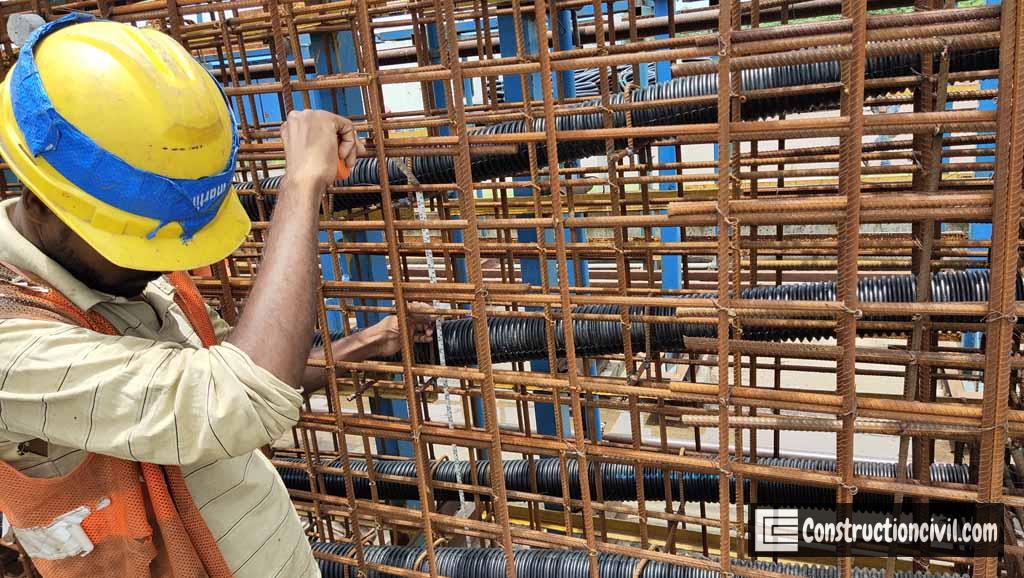
Also, Read: Rusting of Iron Rebar in Concrete – Special Repairing
Prestressing Anchorages:
- Guide Cone: This is a specially treated prestressing element made out of graded cast iron generally embedded into the concrete member and used to distribute the strand forces to the concrete member.
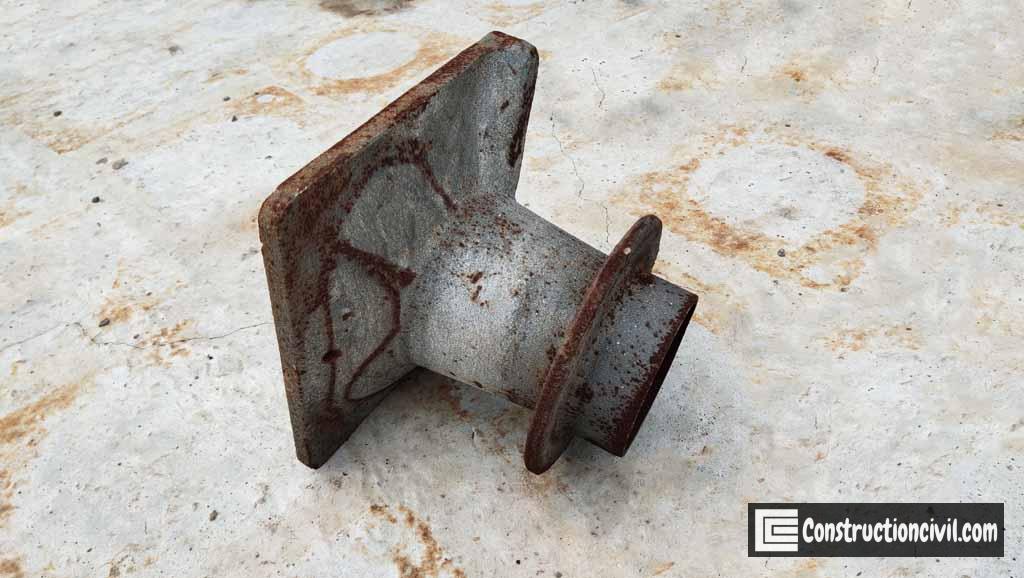
Also, Read: Blowholes/Surface voids/Bugholes in Concrete Surface
- Bearing Plate: After forging of graded alloy steel, a cylindrical round shaped plate component is made, which contains some tapered holes as per design requirement for wedging the Prestressing tendon with the help of grips.
- Grips & Wedges: This is a tapered shaped alloy carbon steel and subsequently hardened and tempered components. These wedges are divided into three equal pieces to act as a split jaw and include serrations inside.
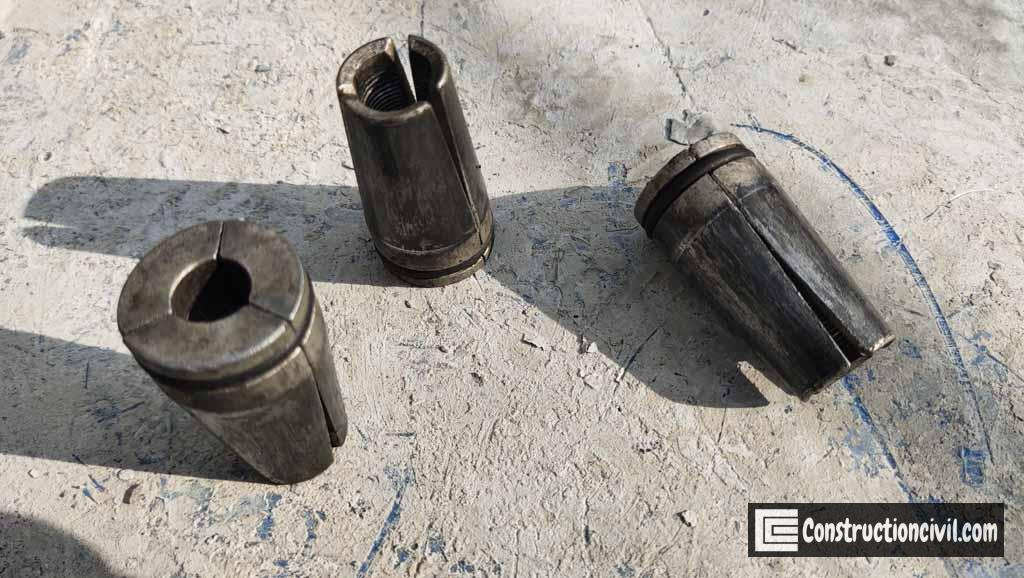
Also, Read: Crane Lifting Safety Procedure- Hazards & Control Measures
Equipment for prestressing of concrete:
- Hydraulic Jack
- Hydraulic electric high-pressure pump
Storage of Prestressing Material:
- Essential care should be taken to avoid contact of HTS strand with the ground.
- Unpacking of HTS strand will be permitted only before cutting and making of cable
- High tensile strength(HTS) strands, anchorages, and sheathing pipe should be appropriately covered to protect dust, rainwater etc.
- Necessary care should be taken to avoid damages to the sheathing duct by other heavy materials.
- Wedges will be protected from rusting by applying rust preventive oil.
- Manufacturers’ test certificates should be verified for prestressing strands, sheathing duct and anchorages prior to using those materials.
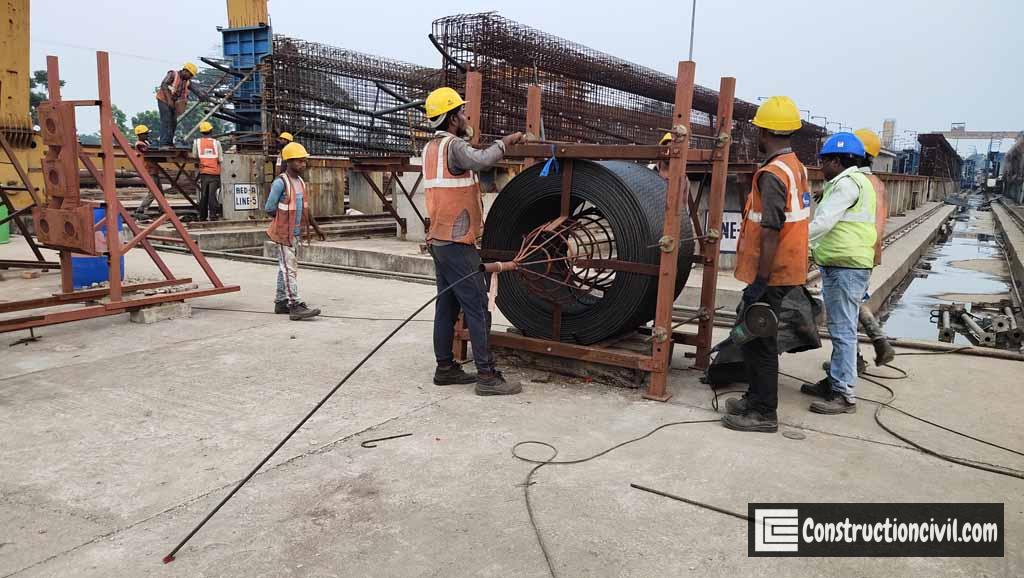
Also, Read: Properties of Concrete – Introduction to Good Concrete Practice
Prestressing of Concrete for I-Girder:
Prestressing Cable Fabrication and Laying:
- The required cable length for prestressing of concrete shall be calculated from the construction drawing considering allowances for profiling and jack grip length.
- With proper safety arrangement, the strand shall be uncoiled so that it is not twisted.
- The strands shall be cut evenly by an abrasive cutter as per the required length.
- In the case of a single pulling jack for prestressing of concrete, both ends of strands in a cable shall be marked to place the strand in the correct configuration in the bearing plate to prevent twisting the cable into the duct. However, this step is not required in the case of multi-pull jacks.
- All the strands in a cable shall be appropriately cleaned with the help of cotton cloth using kerosene/petrol to remove oil/rust/dust etc.
- The sheathing duct shall be installed as per cable profile drawing, and then the cable shall be threaded into the duct manually. During profiling, the sheathing duct shall be rigidly tied with the supports/chair so that the profiles of cables do not get disturbed during concreting.
- The grout vents shall be left if required, as per the specifications.
- Guide Cone shall be fixed with the end blocks as per dimensional requirements specified in the construction drawings, and sheathing ducts shall be connected to the tube units.
- All joints shall be sealed with the help of PVC/Masking tapes.
- Both ends of the duct shall be closed after strand installation, and the projecting length of prestressing strands shall be covered suitably to protect from the entry of dust/dirt during concreting.
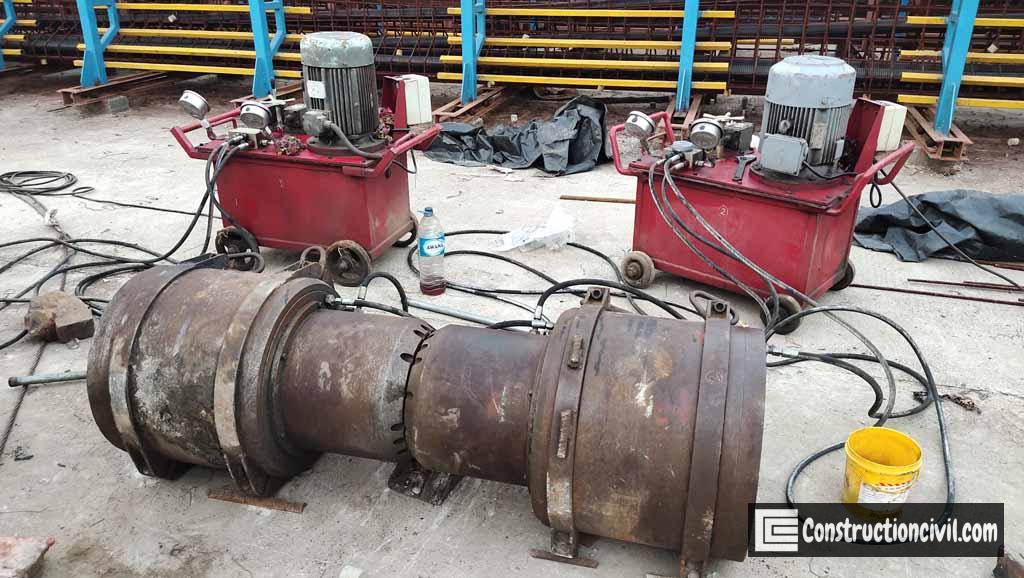
Also, Read: Design Mix of Concrete – Detailed Procedure With Calculation
Concreting:
- During concreting, necessary precautions must be taken to ensure that needle vibrators do not puncture the sheathing ducts.
- During concreting, the cables shall be moved to and fro manually at suitable intervals to ensure that any concrete entering the duct gets disintegrated and does not jam the cable.
Prestressing of Concrete Procedure:
The stressing of cables shall be done from both ends unless there is a restriction because of some other reasons or specified for single end stressing. For accommodating the jacks, a gap of about 1.5 meters shall be left before starting prestressing of concrete. The sequence of stressing activity shall be as follows:
- Before starting the prestressing of concrete, the jacks and pressure gauges shall be checked for a calibration certificate provided by an approved third party.
- Before fixing the bearing plate, hanging arrangements of the jacks shall be made for jack mounting, and strand shall be pulled out by more than the elongation specified and cleaned correctly at the gripping points to ensure that no dirt/dust/rust is there.
- The bearing plates duly cleaned shall be fixed in the proper configuration, and wedges to be fixed to the bearing plates with prestressing strand and tightened using pushing by a suitable pipe of about one-meter length.
- The jacks at both ends or one end specified in the drawing shall be aligned to the cable and fitted over the bearing plate, considering fitting the jack accessories such as the bearing ring and lock plate in position.
- After proper cleaning of master grips of the jacks with petrol/kerosene, and moly lubricant spray shall be inserted through the strands and fixed into the pulling plate of the jack.
- Based on the actual’ E’ value and cross-sectional area of strands specified in the manufacturer’s test certificate(MTC), modified elongation shall be calculated.
- After calculating modified pressure with the help of jack efficiency and ram area stressing pumps shall be connected to the jack through the hose pipes.
- An initial pressure of 50 kg/cm2 shall be applied to the cable to remove the slackness and corresponding elongation measured on the jack ram.
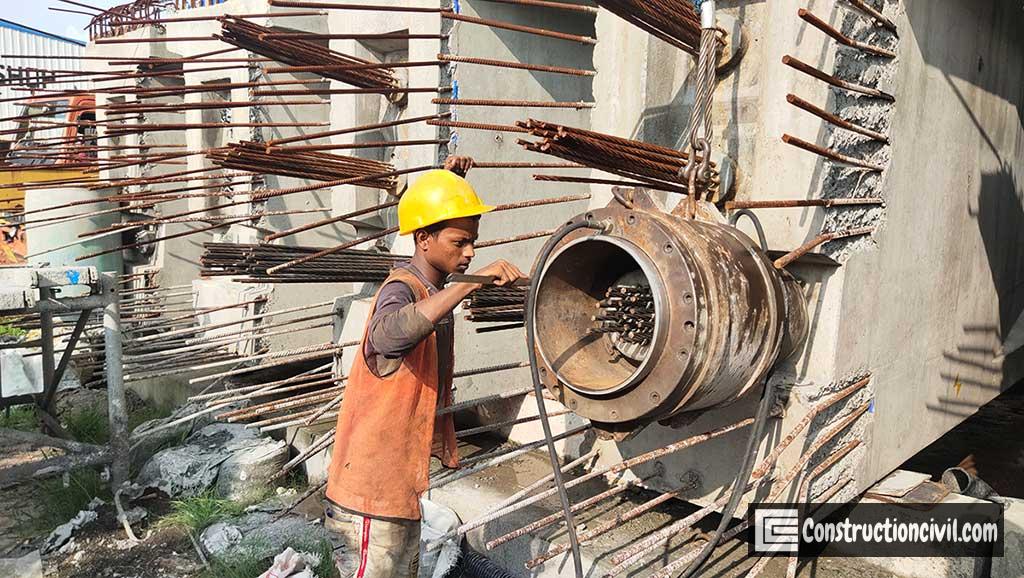
Also, Read: PSC Girder Grouting Methodology
- After each incremental load is applied, the actual elongation to be recorded by measuring extended jack ram and corresponding jack pressure shall also be recorded.
- Since the first reading may still have some error, it shall be subtracted from the last but one reading and divided by the number of intervals until that reading gives the correction factor. For calculating the total elongation, the first reading shall be subtracted from the elongation reading at full load, and the correction factor should be added to the same.
- On reaching the specified full load, the wedges shall be locked hydraulically at specified lock-off pressure as per the drawing of prestressing of concrete.
- Load from the stressing jack should be gradually and steadily transferred to the anchoring wedges to avoid any impact load on the wedges/structure.
- The jack pressure shall then be released, and the elongation measured again at pressure 50 kg/cm2. The difference in elongation at full load and 50 kg/cm2 shall give apparent additional elongation, that is, slip between wedge set of jack and elongation of a strand within the jack.
- After measuring the slip, the jack shall be fully released and retracted.
- No one will be allowed to stand behind the jacks during prestressing of concrete operation to avoid any accident.
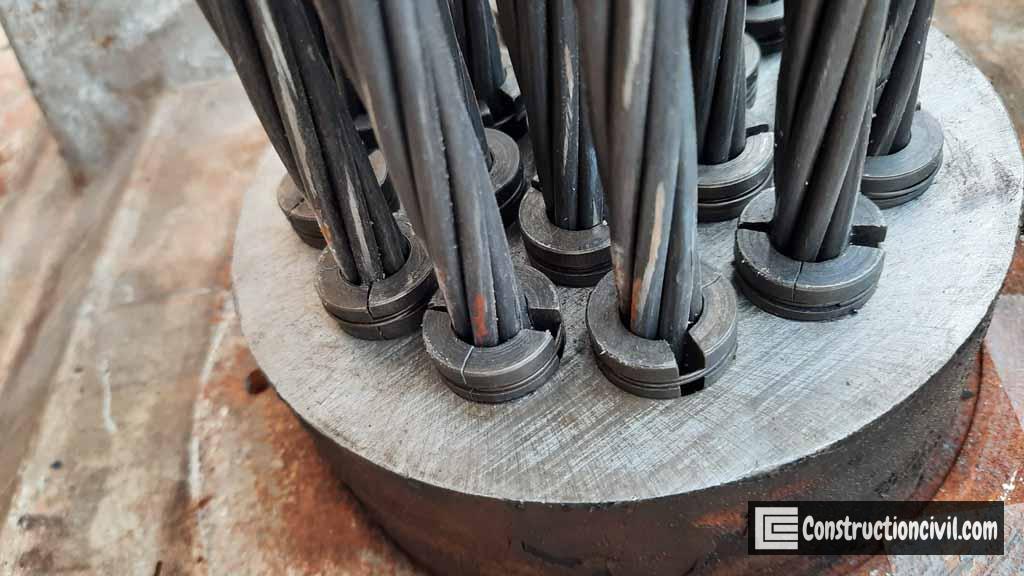
Also, Read: Types of Bridges Based on Span, Materials, Structural Arrangement etc.
Prestressing of Concrete Calculation:
For prestressing of concrete work, we need the following data:
- Load to be applied per tendon.
- Detail of Jack: Ram Area and Jack efficiency
- Extra strand length within the jack for grip
- Jack slip
- Stand Details: Design and actual Modulus of Elasticity (MoE), Design and actual cross-sectional area of Stand
- Design elongation
- The strength of concrete prior to stressing operation
Load Criteria :
After application of required gauge pressure, if necessary elongation does not reach, stressing will continue until elongation is reached, provided the gauge pressure does not exceed 1.05 times the required gauge pressure. If the elongation does not reach even up to 1.05 times of required gauge pressure, the necessary investigation should be done.
- Modified Pressure = (Load / Ram area)/ (Jack Efficiency)
Elongation Criteria:
If the calculated elongation is reached before the calculated gauge pressure, stressing will be continued until the required gauge pressure is reached, provided that the elongation does not exceed 1.05 times of calculated/ specified elongation. In case the elongation exceeds 1.05 times, the necessary investigation should be done.
- Modified elongation = (Design Elongation x Design MoE x Design cross-sectional area of stand) / (Actual MoE X Actual cross-sectional area of stand)
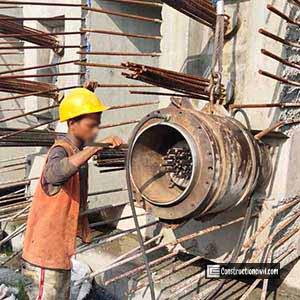


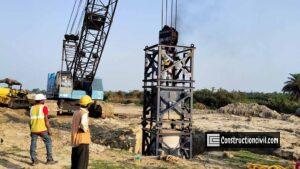
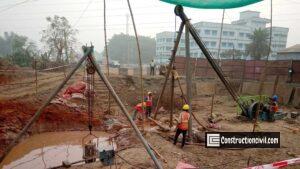
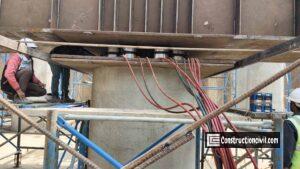
Very good site photos… we need more of them to make the understanding lively…